

Profile and Demand of Asian and Hispanic Food In Metro Atlanta
July 2002
Gerry Wong
MBA - Intern
Dalhousie University
Halifax, Nova Scotia, Canada
Tiny Denq
Baccalauréat ès sciences - Interne
Georgia Institute of Technology
Atlanta, Georgia, United States
Table of contents
Distribution Channels - Profiles
- Pursue Brokers
- Develop Long-Term Relationships
- Provide Process Mapping and Customer Guarantees
- Provide Customer Testimonials
- Keep Informed of Market Trends
- Appendix 1 - Japanese Food Pyramid
- Appendix 2 - Thai Food Pyramid
- Appendix 3 - Indian Food Pyramid
- Appendix 4 - Asian Food Pyramid
- Appendix 5 - Portugese Food Pyramid
- Appendix 6 - Large Retail Store Contact Information
- Appendix 7 - Independent Specalty Store Contact Information
- Appendix 8 - Food Broker Contact Information
- Appendix 9 - Sources
Objective
To determine the profile and demand for Asian and Hispanic foods in Metro Georgia to ultimately identify opportunities for Canadian Food Exporters.
For a detailed listing of county demographics, please refer to Appendix 1.
Methodology & Scope
- General research on the demographics of Georgia was conducted using the Internet, and various resource information at the Consulate (i.e. brochures, newsletters, and web sites). For a list of the webpages researched, and sources, see Appendix 7. Specific county demographics can be seen in supplemental material.
- On site observations were taken at specialized ethnic stores and larger farmer's markets. Subsequent to profiles of Asian and Hispanic diets, a profile of the ethnic products sold in stores, as well as the stores and brokers will be provided in the report.
- Primary research was also conducted with telephone and personal interviews using an informal line of questioning.
- The focus was on metropolitan areas in Georgia, primarily metro-Atlanta, given the higher concentration of Asian and Hispanics in these region.
Findings
Buying Power of Asians and Hispanics
Asian buying power has increased about 128.8% in the past eleven years. With their numbers rising due to significant immigration, Asian Americans are an increasingly important component in the consumer market. They are a well educated and relatively young demographic group. Nationally, Georgia ranks second for the fastest growth of Asian American buying power.
Hispanics buying power has jumped 118% in the past decade, and their current disposable income is US $452.4 billion. Moreover, Hispanics are the fastest growing ethnicity in Georgia. In Georgia, the Hispanic population is posting significant gains for buying power in Clayton, Cherokee, Cobb, Dekalb, Forsyth, Fulton, Gwinnett, and Rockdale counties.
Asian and Hispanic Populations in Metro Georgia
With Atlanta as the hub, Georgia has a population of approximately 8.2 million people, and is experiencing significant growth. Georgia's population represents 15 percent of the whole SE USA region, and is one of the fastest growing regions in the US.
| Country | Asian Population | % of Total | Hispanic Population | % of Total |
|---|---|---|---|---|
| Georgia | 171,916 | 2.1 | 433,882 | 5.3 |
| Cherokee | 1,141 | 0.8 | 7,695 | 5.4 |
| Cobb | 18,587 | 3.1 | 46,964 | 7.7 |
| Fulton | 24,823 | 3.0 | 48,506 | 5.9 |
| Clayton | 10,629 | 4.5 | 17,728 | 7.5 |
| Dekalb | 26,718 | 4.0 | 52,542 | 7.9 |
| Gwinnett | 42,360 | 7.2 | 64,137 | 11.0 |
| Clarke | 3,173 | 3.1 | 6,436 | 6.3 |
| Forsyth | 247 | 0.8 | 5,477 | 5.6 |
Source: U.S. Census Bureau (2000)
Hence, the market potential for ethnic foods is bound to grow, given the increasing population and purchasing power of Asians and Hispanics in the SE USA region. In such a competitive environment, store merchants and suppliers will be more conscience of the place, product, price and promotion of their purchases, which may create more opportunities in Canada.
Asian Diets
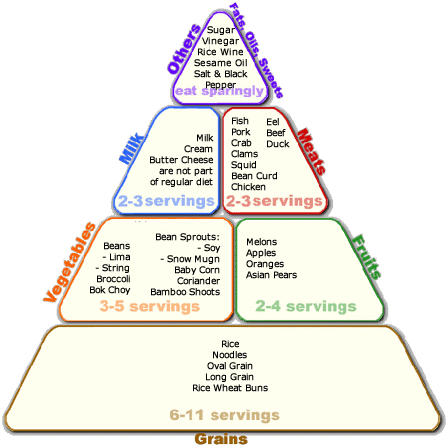
Source: SEMDA - Chinese Food Pyramid
Please refer to Appendix 1, 2 and 3 for the Japanese, Thai, and Indian Food Pyramids respectively. For an overall Asian Food Pyramid with a discussion on the health benefits of an Asian diet, please refer to Appendix 4. In this case, the Chinese Food Pyramid is quite reflective of the Asian Diet in general, and an overall profile will be provided below. In many cases, Asian food preparation is very similar, and the main distinguishing ingredients are the seasoning salts and sauces.
Rice - Asian meals are almost always accompanied by white rice. A staple of their diet, rice is perhaps the single most important component of the Asian diet. There are many selections of rice including sticky rice, brown rice, wheat rice, and coconut rice.
Noodles - Also a common staple of Asian diets that comes in various types (i.e. flat, thick and fried) including rice noodles, bean vermicelli, egg noodles, udon noodles, ramen noodles, and flour noodles (pasta).
Meat Products:
- Beef - steak, shredded, intestines, heart, kidneys, tongue
- Pork - BBQ Pork, feet, ears, snout, skins, thick sliced bacon
- Chicken - roasted chicken, chicken feet
- Duck - roasted duck, duck feet
This category also includes thinly sliced meats.
Sea Food:
- Fish - Flounder, Trout, Frogs/Turtles, Red Snapper, Sea Bass, Squid, Eel, Oyster, Shrimp, Octopus, Salmon, Tuna, Calamari
- Shell Fish - Blue Crab, Softshell Crab, King Crab, Clams, Prawns, Crawfish, Lobster
Produce: A large emphasis is placed in freshness and quality, and large selection is also important.
Vegetables (in addition to vegetables found in mainstream stores)
- Bitter Melon
- Bok Choy
- Chinese Broccoli
- Chinese Celery
- Chinese Eggplant
- Cilantro
- Daikon
- Ginger Root
- Basil
- Kohlrabi
- Napa Cabbage
- Yu Choy
- Water Cress
- Kon Shim Choy
- Bean Sprouts
- Snow Peas and their leaves
- Leak and Chives
- Korean Melon
Fruits (in addition to fruits found in mainstream stores)
- Asian Pears
- Lychee or Longan
- Pineapple
- Mango
- Papaya
- Guava
- Coconut
- Persimmon
- Grapes and Muscats
- Fruit Melon
Other popular Asian food products include:
Dry groceries - azuki beans, mixed grain cereals, salted peanuts, roasted sunflower and watermelon seeds, powdered milk, soybeans, imported snack crackers and sweets, starches, rice snacks, jelly candies, and tapioca pearls.
Dairy products - minimal in Asian diets; soy milk, and Yakult yogurt drinks; Gelatins - mainly found in desserts in a variety of gelatins.
Beverages - tea, winter melon tea, fruit juices, and grass jelly drink
Combination Foods:
Japanese :
Fish Cakes - meat, grain
Tuna Noramaki - meat, grain
Cucumber Noramaki - vegetable, grain
Thai :
Spicy Prawn Salad - vegetable, meat
Thai Ice Tea - other
Pad Thai - grain, meat, fat
Baked Custard - meat/protein, fat
Hot and Sour Stir Fried Vegetables with Rice - vegetable, grain, fat
Indian :
Biryani - grain, meat
Samosas - grain, vegetable, meat, fat
Kheer "rice pudding" - grain, milk
Curry - meat, vegetable
Hispanic Diets
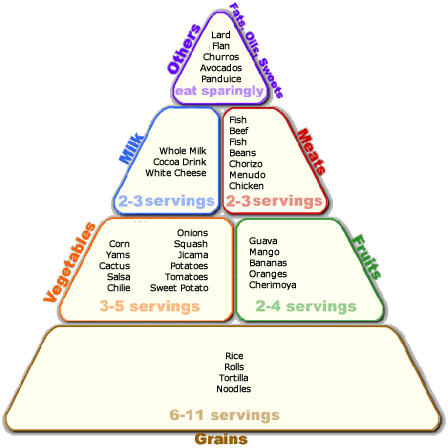
Source: SEMDA - Hispanic Food Pyramid
The Hispanic population spends more money on food than the average American. They are willing to spend more for better quality products and are loyal to businesses and brands able to provide that. The following list is a fairly complete list of items deemed important by Mexigrocers to successful marketing to Hispanic shoppers (Please refer to Appendix 5 for the Portuguese Food Pyramid).
Tortillas:
Equivalent to rice to Asians, Fresh tortillas are the staple of the Mexican
diet, and an extremely important item to have in most meals.
- Flour - fajita (6in) soft taco (8in) burrito (10in) Often sold in bags of 20.
- Corn - Masa mix fastest growing because of advancing Mexican population.
Dairy Products:
- Cheeses (Quesos) -- Chalco, El Viajero, La Vaquita, Mexica, Tropical, V&V Supremo, Cacique, Los Portales are some brands to consider.
- Chorizo -- spicy hot Mexican pork sausages. Fino and economy rolls (place next to cheeses in refrigerated cases).
- Drinkable Yogurts -- Liquado, Yonique
- Cup Yogurts -- mango, guava, pina, fresa from Sabor Latino (Johana Foods)
- Nectars -- Natural Country (sold in dairy case) preferably cold filtered
- Gelatins, Flan -- desserts are important! Have variety of gelatins.
- Horchata -- rice based milk substitute (45% Hispanics lactose intolerant) Don Jose
- Citrus Punches -- Tampico, Acapulco, Citrinia
- Salsa -- more spicy than typical salsa, should be marketed in dairy/deli case
- Guacamole -- 100% Hass avocado (not mixed with sour cream)
Meat Products:
- Offals -- beef (heart, brains, kidneys, marrow guts, tongue), pork (ears, snout, skins, tails, tongue, chivo), goat and sheep heads
- Fish -- Ceviche, Bacalao (salted cod), Talapia, Crab Salads
- Packaged items (chorizos, salamis)
The meat department is considered a high traffic area, and a good place to market other items. This category also includes thinly sliced meats, and hot lunches (spicy fried chicken)
Produce:
Large emphasis on freshness and quality. Large selection is important.
- Aloe/Savila
- Hass Avacado
- Chayote
- Cilantro
- Green Onions/Cebolita
- Poblano, Serrano and Jalapeno Peppers
- Baby bananas, Plantains, Pencas de Maguey (Long Banana Leaves)
- Papaya, Guava, Water Coconut
- Green Squash/Calabzitas
- Limes
- Cactus pears, Yucca root, Sugar Cane
- Lettuce, Cabbage, Mushrooms, Potatoes
- Corn husks
- Bag spices, Dried peppers
Packaged Products:
- Salsa (Hispanic Styles)
- Guacamole (Yucatan)
- Peppers - San Diego Marinated
- Nectars - Jummel
- Packaged tropical fruits
Combination Foods: Mexican - Guisado - Stew with Vegetables and Meat
Quesadilla - Tortilla with Meat and Cheese
Burrito - Flour tortilla with Beef, Beans, Cheese, or other fillings
Portuguese - Acorda a Alentejana (starch, meat): a galic-bread-egg soup.
Gaspacho a Alentejana (starch, vegetable): a type of gazpacho soup.
Figos com Presunto (fruit, meat, fat): fresh figs with smoked cured ham.
Caldo verde (vegetable, meat, fat): green soup.
Arroz doce (milk, meat, starch, fat): rice pudding.
Distribution Channels - Profiles
Large Retail Stores
- Whole Foods - Whole Foods is a retail chain specializing in organic and natural foods, and seeks to provide a 'little bit of everything' for it's customers. Having recently acquired Harry's Farmers Market, Whole Foods aims to retain much of its diverse product line found in Harry's while integrating their unique products. Ethnic varieties of produce (including Oriental vegetables such as bok choy and yu choy; and tropical fruits) are available in some Whole Foods and an expanded selection of organic foods could be found in old Harry's locations. Harry's stores have also been known to carry spices, seasonings, and other groceries that are geared towards a minority consumer. It is likely that some of these items will remain in the shelves of Whole Foods. Whole Foods' produce is bought primarily directly from the growers, and most groceries carried are private label items not found in 'mainstream' stores.
- Wal-Mart - True to Wal-Mart's formula for success, the new Super Wal-Marts' grocery section continues to use low prices as a way to garner customer loyalty. While most of products available are mainstream non-specialty items, a large percentage of the shoppers at Wal-Mart are of Hispanic (Mexican) origin (dependent on location). In most cases, these store take this into consideration, and stock tortillas (by pasta section) from Ole Mexican foods, desserts, brand name dried spices, seasonings, canned foods and sauces, and snacks by the checkout counters. These flavors are geared to entice impulse purchases from Hispanic shoppers. (i.e. combination fruit flavored frozen treats, jalapeno flavored sunflower seeds), much like Wal-Mart's strategy with other products. Of note, Wal-Mart has its own Supplier Proposal Review guide which is conducted on-line and review inquires from interested prospective suppliers through e-mail. Thus, any potential supplier must follow the procedures indicated at Wal-Mart's web site address (http://www.walmart.com)
- Kroger - Like Wal-Mart, Kroger carries mostly mainstream produce and groceries, although there's are emerging aisles that contain ethnic foods (mostly dry goods, canned beans, and tortillas). Kroger has the largest piece of the food and grocery market in Georgia. However, separate marketing areas operate independently from buying and merchandising, so the prospect of selling ethnic specialty foods to selected area stores is a small, but not an improbable possibility. Some Kroger stores offer hot Chinese foods as an alternative to their in-store deli's.
- Publix - A fierce competitor with Kroger, Publix offers a similar selection of mainstream foods as the aforementioned stores. About two years ago, Publix introduced sushi into their deli section. Kroger and Publix tend to follow each other's strategies, and monitor pricing and promotions.
Please refer to Appendix 6 for contact information for large retail grocers.
Independent Speciality Stores "\l2
There are a number of speciality stores in the Metro Atlanta region that cater their product offering to fit the demands of the ethnic consumer. A noteworthy few include the following stores:
- Ranch 99 Supermarket
- Atlanta Farmers Market
- Buford Highway Farmers Market
- La Carnecia.
- Dekalb Farmers Market
With the exception of the Dekalb Farmers Market, all of these specialty supermarkets are located along Buford Highway in Doraville, GA. Thus, this area has become a centralized, destination area for ethnic food shoppers, and resident to many Hispanics and Asians. Each of these stores were visited, their product offerings were noted, and attempts were made to interview owners and decision-makers. The following section will profile each of the speciality stores.
- Ranch 99 - Ranch 99 is a popular store with locations in various Chinatowns across the US. They stock a variety of Oriental vegetables, tropical fruits, Oriental snacks, sauces, pastries, desserts, dry goods, frozen foods, canned goods, fresh and frozen seafood, meats, offals, soft drinks, dining ware and utensils. Shoppers are pre-dominantly of Asian descent, as they carry only Asian foods. The products arrive on the shelves through various routes: watermelons, for example, are bought directly from Georgia growers, while mangos are purchased from the Ciruli Brothers distribution center in Arizona. Price is the determining factor for buyers.
- Atlanta Farmers Market - A large store with extensive line of products that appeals to both Hispanic and Asian shoppers. They provide most of the "essential" products needed to market toward Hispanic consumers (cheeses, chorizos, tropical fruits, nectars, drinkable yogurts) and toward Asian consumers (Oriental vegetables, snack goods, dry goods such as noodles, flours, and rice, fresh meats and offals, fresh seafood, sauces, canned goods, and prepared/precooked meals). Their Hispanic groceries can be traced back to local distributors like Diaz Foods. Their Asian produce and groceries are mostly from California and New York, though their quail and durian fruit are from Canada. Much of their inventory comes from Supervalue, the central distribution center for the Atlanta Farmers Market.
- Burford Highway Farmer's Market - Korean owned, this farmer's market offers an extensive variety of produce appealing to many consumers. The grocery sections are diversified by nationality, with aisles for Hispanic, Korean, Chinese, Japanese, and American foods and products. In addition, a large selection of fresh baked breads, meats and seafood are also available.
- Dekalb Farmers Market - Dekalb Farmers Market prides itself in the international aspect of its selection. In contrast to the Buford Highway Farmer's, products are segmented more by category than by ethnicity. There is a section that serves ready- to-eat items of several ethnicities in a cafeteria setting, an in-store bakery, and also a large selection of fresh (and live) seafood. Dry groceries include German biscuits and snack items, various flours and grains, dry beans, spices, pastas, and rice to satisfy Hispanic and Asian tastes. A small freezer section also exists, carrying mostly frozen vegetables, a good portion from Fresh Frozen Foods. Produce, primarily grown in California, and some from Georgia, and Mexico, make up the bulk of the store. Dekalb Farmers Market also has a small selection of Oriental vegetables, mangos, papaya, star fruit, aloe spears, cactus pears, durian and other oddities alongside more mainstream produce items.
- Carnecia Hispana - A grocery store dedicated to Hispanic shoppers, La Carnecia provides a vast selection of dry spices, fresh corn and flour tortillas, juices and nectars, canned goods, fresh meat and snack items. The prevailing majority of the products are well known brands from Mexico, Puerto Rico, and various South American countries. As mentioned, Hispanic shoppers are known to be very brand-loyal, so it is important that any grocery store hoping to capture the loyalty of a Hispanic consumer support popular brands such as Goya, Liquado, Yonique, Jumex, Jarritos and Mexica.
Please refer to Appendix 7 for contact information for independent speciality stores.
Food Brokers
Essentially, brokers are intermediaries or representatives that can put Canadian food exporters in contact with local businesses. Their value lies in their ability to match the buyers with the sellers or suppliers, and provide qualified contact information based on the profiles and needs of both parties. An experienced food broker should have an extensive knowledge of the local market, and prospective buyers.
- Buckhead Beef - Serves almost any food service establishment in the area, from restaurants to large supermarket chains, to local "Mom & Pop" stores. While they specialize in beef, they also broker fresh and frozen seafood, meats, and offals. Canadians would most likely be successful pushing shellfish and farmed salmon. Buckhead Beef acts as the middle man between meat packers and the supermarkets and restaurants. (Ranch 99 is one such supermarket).
- Diaz Foods - Brokers Hispanic food products only. They are one of the most prevalent distributor of Hispanic foods in the metro area, servicing large franchises like Kroger to independent food stores to restaurants. They have stressed the importance of brand name in marketing to the Hispanic consumer, and carry plenty of popular labels from Mexico and South America (i.e. Jumex, Nestle, V&V, Goya, Maseca, Juanitas, Cacique, Jarritos, Barrilitos, La Costena, Cozumel, Los Amigos, and Vigo). Diaz Foods purchases primarily from manufacturers in Mexico, California and Texas.
- Ole Mexican Foods - A distributor of Mexican products, and specialists in tortillas (corn and flour), Ole Mexican Foods delivers to restaurants and chain stores alike. Some of their products (i.e. sauces, preserved jalapenos, mole, pasta, concentrated fruit juices, and tortilleros) are imported from Mexico, but they have well developed manufacturing capabilities as well. Their own tortillas are sold under four brands, "La Bandarita," "La Popular," "Ole Brand," and "Food Service." Among the other Ole manufactured products include cheeses, sausages, breads, and wraps.
- Sanwa Growers - Originally began as a Canadian business out of Ontario. The owner (Mr. Tony Leung) migrated to Florida to grow vegetables during the winter months, and since then, business has expanded rapidly. Currently, they service restaurants as well as supermarkets, and have distribution centers in Atlanta, and in Florida. Key products include bok choy, napa cabbage, daikon, kohlrabi, Chinese eggplant, basil, cilantro, and herbs such as chives, sage, tarragon, rosemary. (Sanwa Growers: About Us)
Please refer to Appendix 8 for contact information for food brokers.
Restaurants
Restaurants also have the tendency to purchase from distributors or brokers, rather than retail stores for pure shipping purposes. Often these restaurants deal with the same food purveyors as the supermarkets. Examples include Buckhead Beef, Sanwa Growers, Sysco, and Diaz Foods.
Conclusions
Evolution of Asian and Hispanic Food Diets
Surprisingly, many popular Asian and Hispanic dishes were originated in America. In many cases, Americans have come to associate foods with certain cultures that never existed in their supposed countries of origin. Other foreign dishes have become "mericanized" leaving little in common with their countries' traditional cuisine1. For example, chop suey cannot be found in China, and the same goes for Singapore noodles. Similarly, burritos and nachos did not originate from Mexico. This 'Americanization' of ethnic food is a way immigrants tried to adapt to their new home. Often times, they had to make the most of whatever ingredients they could find. Many of these foods have since been widely accepted by the masses, which creates more mass selling opportunities. This "evolution" of ethnic food can now be seen in both specialized and mainstream retail food stores, and more and more, there is less distinction between the two. However, there will always be a demand for pure ethnic foods, where only speciality stores carry these products.
Importing Ethnic Foods from Canada
In order for Canadian operations to be successful selling in the metro Atlanta area, businesses need to ensure they can provide high quality products at competitive prices to SE USA retailers or distributors. Many of the independent supermarkets indicated that low shipping costs and product prices are a priority, and a major determining factor in who they conduct business with. With the exception of seafood, very few brokers indicated that they did business with Canada, and the outlook is relatively bleak for two primary reasons:
- Firstly, these stores may perceive Canada as being farther away than it actually is, and fear the additional costs and cross border logistics as a result. Essentially, this is a price and policy issue that Canadian exporters must clarify. California seems to be a major hub for product shipments, and some of these same products could very well be imported from Eastern and Atlantic Canada, particularly sea food. Although variable, US businesses also have a large dollar advantage against the Canadian dollar which can further magnify the price advantage.
- Secondly, many of these stores have developed a long term relationship from their suppler or distributor, and are reluctant to change their operations. This creates a barrier of entry to Canadian exporters related to brand loyalty, proximity advantages, economies of scale, ability to provide contingency inventories, not to mention emotional attachments.
Asian Foods - As alluded to earlier, most Oriental products and produce come from California. Sanwa Growers may be an exception, with a distribution centers in Atlanta, and Florida and an office in Canada. Some products found with Canadian origins are durian (a pungent spiky looking fruit), sausages, lobsters, and crab leg clusters. It would be helpful to find out where the Oriental supermarkets in Toronto and Vancouver are buying from. Toronto might have some established food manufacturers or distributors who could challenge the Californian influence. However, the case may be that the Toronto Chinatown is supplied by Californian businesses. Morever, Vancouver with its extremely large Asian and Indian population may also have numerous suppliers and distributors that can service the SE USA.
Hispanic Foods - Most of the brands that have customer loyalty are manufactured in Mexico. Given the loyalty to product branding, Canadians may have a difficult time tapping into this market. Meat packers in Texas and the middle United States already have strong relationships with brokers/distributers in the metro area (though they said meat packers may have plants in Canada), and the proximity to Mexico and South America is a definite advantage. The only avenue that seems feasible would be by way of seafood. Hispanics are not known to consume a large quantity of seafood, but some varieties to consider are: tilapia (white frozen fish), bacalao (salted cod), and ceviche.
Recommendations
Pursue Brokers
A SE US food broker may be the most efficient and effective method to penetrate the demand for Asian and Hispanic food market in the SE US region, gain local market representation, and tap into established networks with local businesses. Similarly, distributors in the SE US may also utilize a Canadian food broker to import these ethnic food products into this region. In other words, a broker will be in a position to know market conditions, trends, and buyer requirements, and reduce the amount of primary research required to seek buyers. Brokers will also often develop long-standing relationships already established with the local food stores. In addition, pricing, distribution, location, product management, shipment, and promotional activity all need to be monitored, and a broker can provide these services. Problem resolution can also be difficult to achieve through long distance from Canada, and an in-market representative can handle these types of issues. Canadian Food Exporters must also feel that the broker will provide fair portion of their attention and loyalty.
Develop Long-Term Relationships
This can effectively serve to create an intangible barrier of entry for Canadian exporters. As mentioned, many SE US food stores may not entertain new sellers simply because they are loyal to their current supplier. This long-term relationship is something Canadian businesses must strive to attain. Once business has been initiated, maintaining a mutual long term relationship with customers, brokers, and other industry contacts will help these businesses to establish a presence and to develop their reputation as quality food supplier or distributor.
Provide Process Mapping and Customer Guarantees
One of the main concerns of US importers is crossing the border and being in compliance of US customs. It would be beneficial for Canada and its exporting companies to provide details of processes in growing, producing, manufacturing, and transporting product. Recording and establishing standardized methods can also benefit by identifying ways to improve the flow of goods, and to enable a consistent product and service offering. Furthermore, this will also serve to facilitate a price package to interested buyers. To further attract customers and reduce their concerns of importing food, Canada can also provide customer guarantees or insurance in areas such as food quality and freshness, inspections, on-time delivery and shipping.
Provide Customer Testimonials
Providing the contact information of satisfied businesses will also serve to reduce the concerns that US companies have of importing food from Canada. Prospective customers can arrange to have discussions with current clients or brokers on their experience in doing business with Canadian companies. Visits and face-to-face meetings can be conducted on both sides of the border to foster relationships.
Keep Informed of Market Trends
Like any product, food can be susceptible to short term and long term market trends. It would be in Canada's best interest to keep atop of the market trends in the regions they plan to export to, and recognize the current demands of the customer, because these trends may vary from location to location. As mentioned, association membership as well as the attendance of SE US Trade Shows related to the food industry can help Canada achieve this.
Appendices
Appendix 1 - Japanese Food Pyramid

Source: SEMDA - Japanese Food Pyramid
Appendix 2 - Thai Food Pyramid
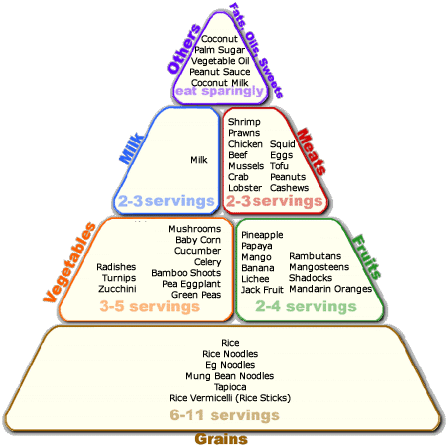
Source: SEMDA - Thai Food Pyramid
Appendix 3 - Indian Food Pyramid
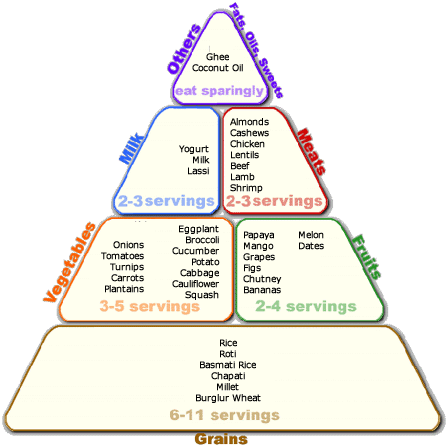
Source: SEMDA - Indian Food Pyramid
Appendix 4 - Asian Diet Pyramid
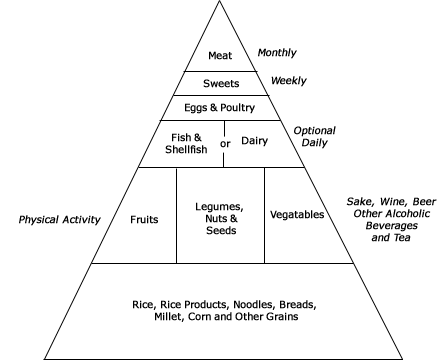
Source: Cornell University, Science News
Cornell and Harvard University researchers unveiled an official Asian Diet Pyramid. This pyramid is based on a massive survey of more than 10,000 families in mainland China and Taiwan designed to study diet, lifestyle and disease in China. The research increasingly Asian Diets to be linked to much lower rates of certain cancers, heart disease, obesity and, in some cases, osteoporosis and other chronic, degenerative diseases than those found in the US.2
Overall, the Asian diet is comparatively lower in total fat. As such, this pyramid reflects the traditional, plant-based rural diets of Asia, which may differ somewhat with that of Asians living in the US, but can still be used as a traditional basis of the Asian diet in general. The Asian Diet Pyramid emphasizes a wide base of rice, rice products, noodles, breads and grains, preferably whole grain and minimally processed foods, topped by another large band of fruits, vegetables, legumes, nuts and seeds. Moreover, a small amount of vegetable oil and a moderate consumption of plant-based beverages, including tea (especially black and green), sake, beer and wine are also consumed. Servings of dairy products are minimal. Interestingly, dairy products (well regarded in North America for their calcium) are thought by many to inhibit the development of osteoporosis, but the Asian plant-based, dairy- free diets are linked to a low rate of osteoporosis.
Appendix 5 - Portuguese Food Pyramid
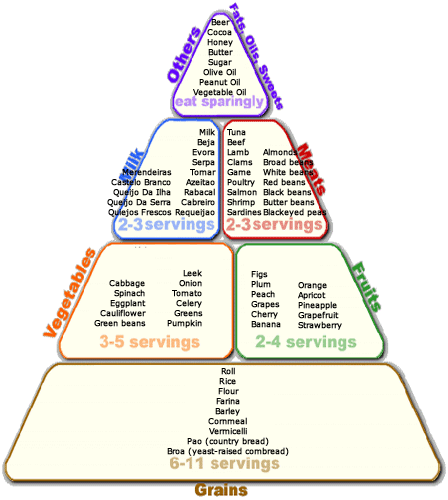
Source: SEMDA - Portuguese Food Pyramid
Appendix 6 - Large Retail Store Contact Information
Whole Foods
Mr. Alex Rilko
Produce Buyer
1180 Upper Hembree Rd.
Alpharetta, GA 30076-1142
Tel: (770) 263-5347
Corp Tel: (770) 667-8878
Fax: (770) 772-9063
Wal-Mart
702 SW 8th Street 72712
Bentonville, Arkansas
Tel: (479) 273-4000
Kroger (Atlanta Marketing Area)
2175 Parklake Dr.
Atlanta, GA 30348 - 5520
P.O. Box 105520
Tel: (770) 496-7400
Fax:(770) 496-7449
Publix Corporate Office (RBU - Retail Business Unit)
1936 George Jenkins Blvd.
Lakeland, Florida 33815
P.O. Box 407
Tel: (863) 688-1188
Fax:(863) 616-5793
Appendix 7 - Independent Specialty Store Contact Information
Ranch 99
5150 Burford Highway
Doraville, GA 30340
Tel: (770) 458-8899 ext.102
Fax: (770) 458-1800
Atlanta Farmers Market
Mr. Don Tieu
Vice President
4166 Buford Highway, Suite 1115
Atlanta, GA 30345
Tel: (404) 325-3999
Fax: (404) 325-3311
Buford Highway Farmers Market
Mr. Tony Lee
5600 Buford Highway
Doraville, GA 30340
Tel: (770) 455-0770
Fax: (770) 455-0625
La Carnecia Hispana
2945 Woodbine Highway
Augusta, GA 30071
Tel: (770) 300-9560
Dekalb Farmers Market
3000 East Ponce de Leon Avenue
Decatur, GA 30030
Tel: (404) 377-6400
Fax: (404) 377-9274
International Farmers Market
Mr. Fonzie Ahn Phan (Partner)
5193 Peachtree Industrial Boulevard
Chamblee, GA 30341
Tel: (770) 455-1777
Fax: (770) 451-7474
Appendix 8 - Food Broker Contact Information
Buckhead Beef
2194 Marietta Blvd.
Atlanta, GA 30318
Tel: (404) 355-1949
Fax: (404) 355-4400
Diaz Foods
5500 Buckhead Dr.
Atlanta, GA 30336
Tel: (404) 344-5421
Fax: (404) 344-3003
Ole Mexican Foods
6585 Cresent Dr.
Norcross, GA 30011
Tel: (770) 582-9200
Fax: (404) 582-9400
Sanwa Growers Inc.
Ms. Connie Leung
Vice President
5107 State Road 674
P.O. Box 338
Wimauma, FL 33598-0338
Tel: (813) 633-8683
Fax: (813) 633-8682
Fresh Frozen Foods
Thomas Fusco
Regional Sales Manager
P.O. Box 215
Highway 129 North
Jefferson, GA 30549
Appendix 9 - Sources
Websites:
- http://www.census.gov
- http://chinesefood.about.com
- http://www.dekalbfarmersmearket.com
- http://www.diazfoods.com
- http://www.elmonterey.com
- http://www.georgiastats.uga.edu/2000crace.html
- http://www.hacr.org/
- http://www.mexigrocers.com
- http://www.news.cornell.edu/science
- http://www.olemexicanfoods.com
- http://www.sanwagrowers.com
- http://www.semda.org/
- http://www.walmartstores.com
- http://www.wholefoods.com
- http://www.selig.uga.edu/forecast/GBEC/GBEC7800.PDF
Other sources:
- "The Hispanic Consumer" Shelby Report, Southeast Edition (July 2002)
| Date Modified: 2004-04-02 | Important Notices |